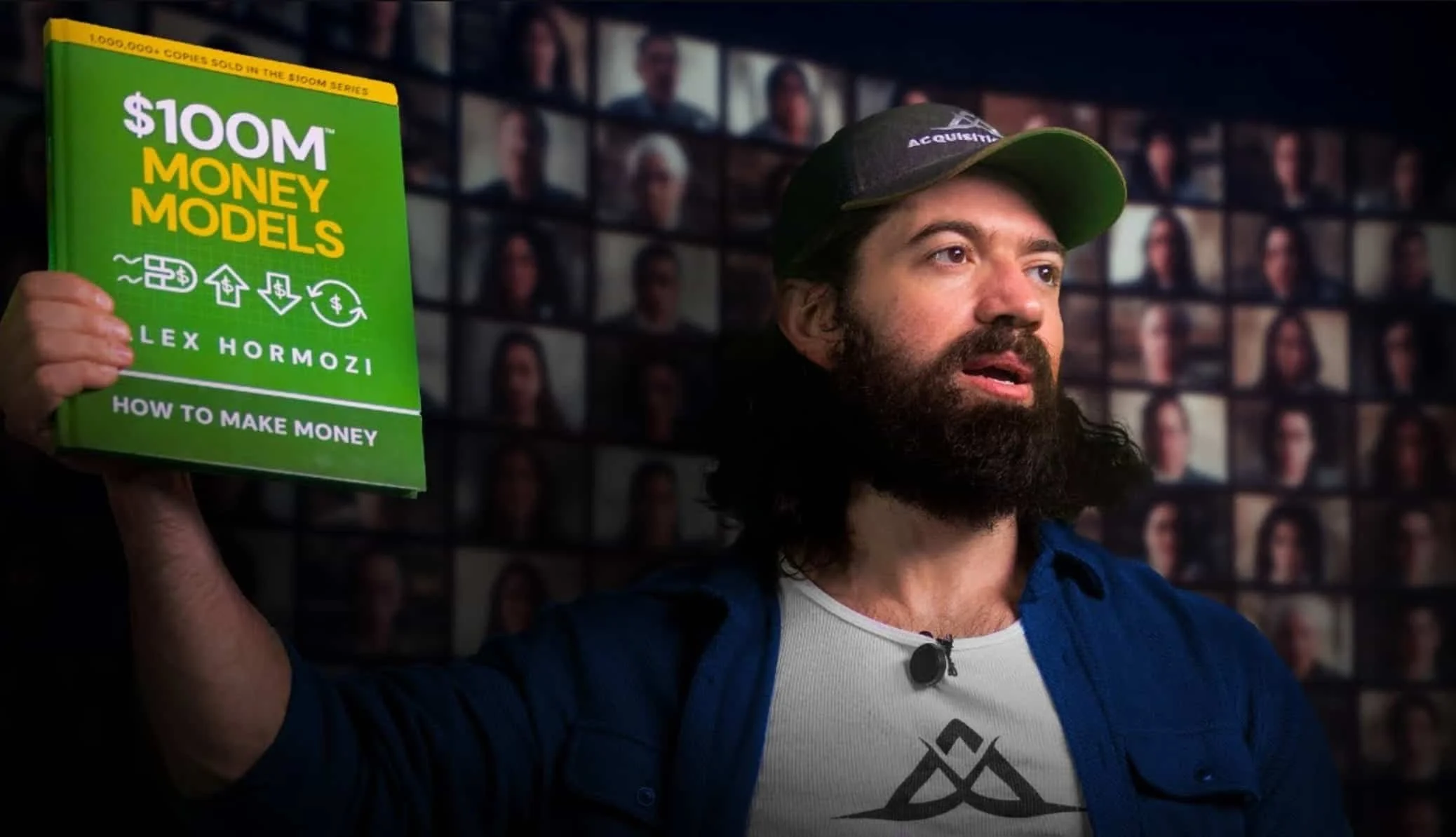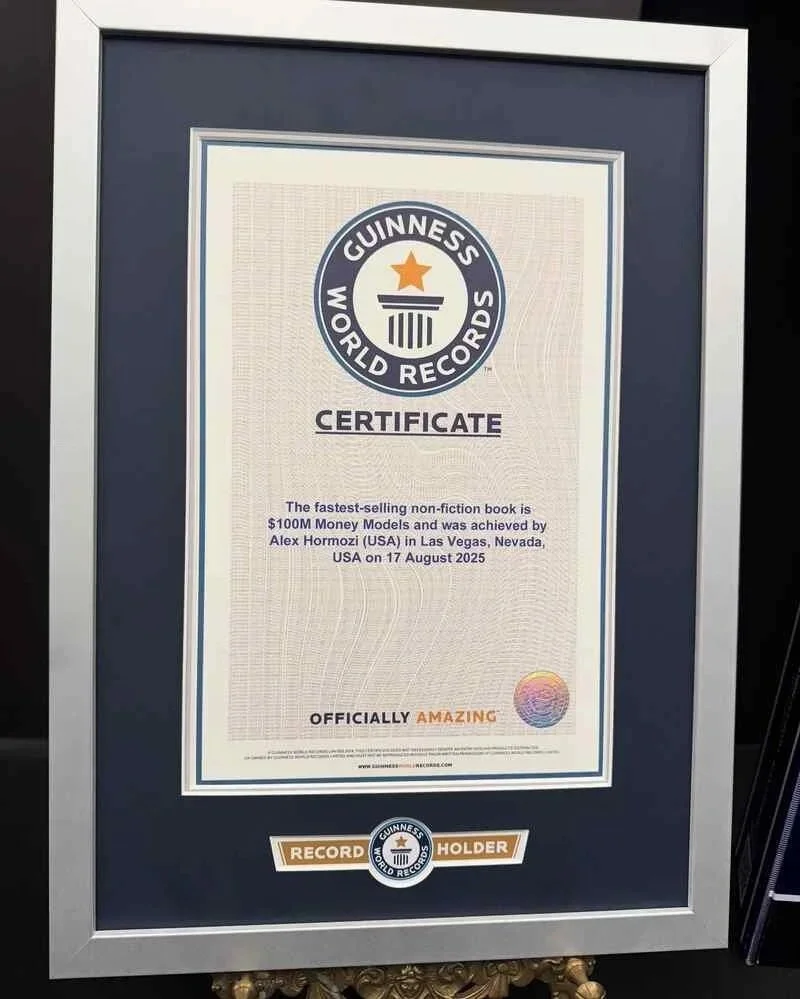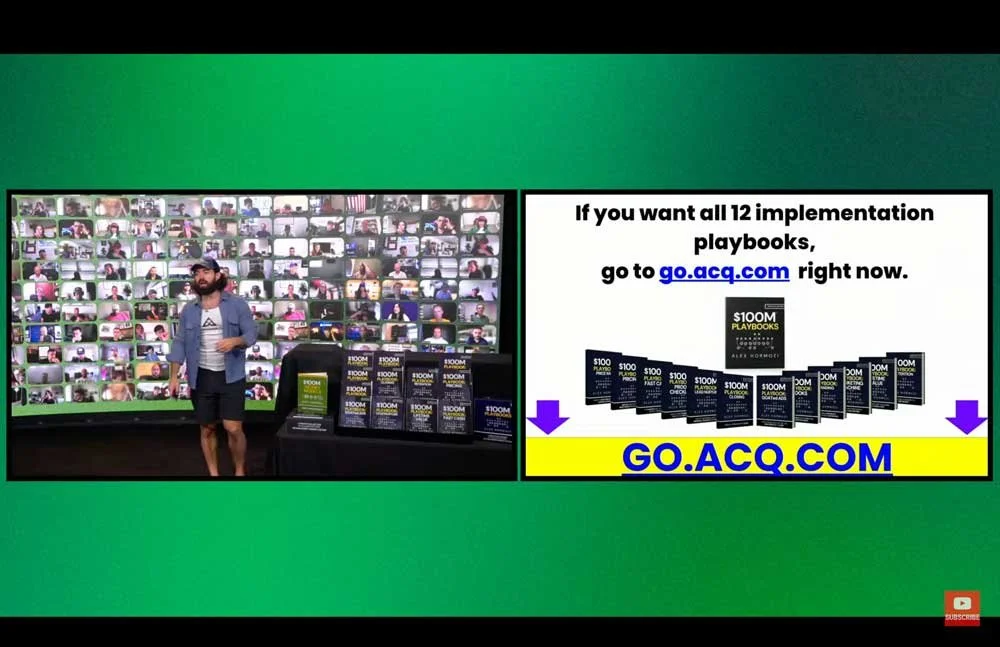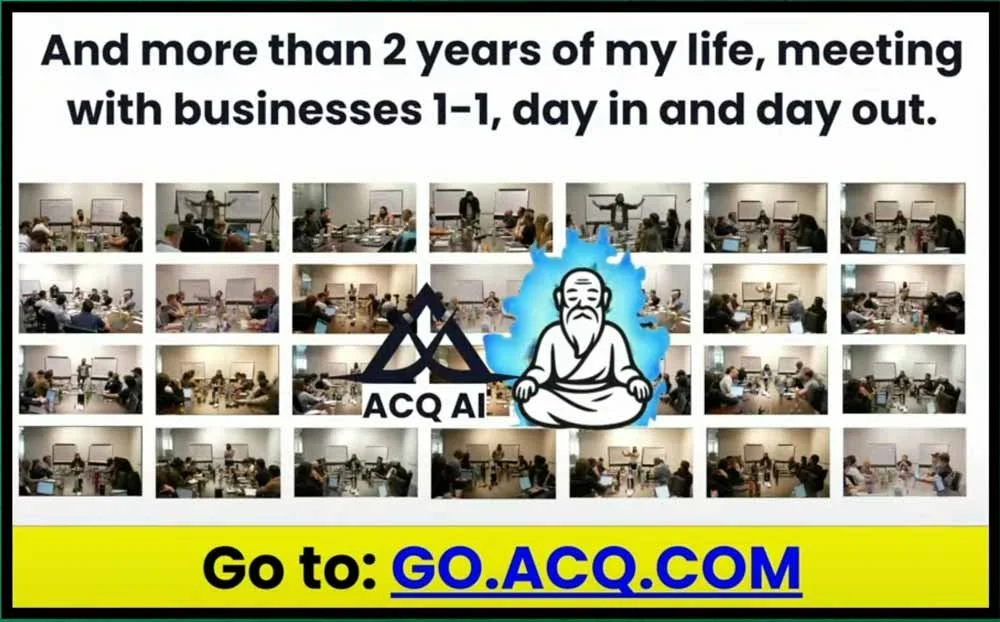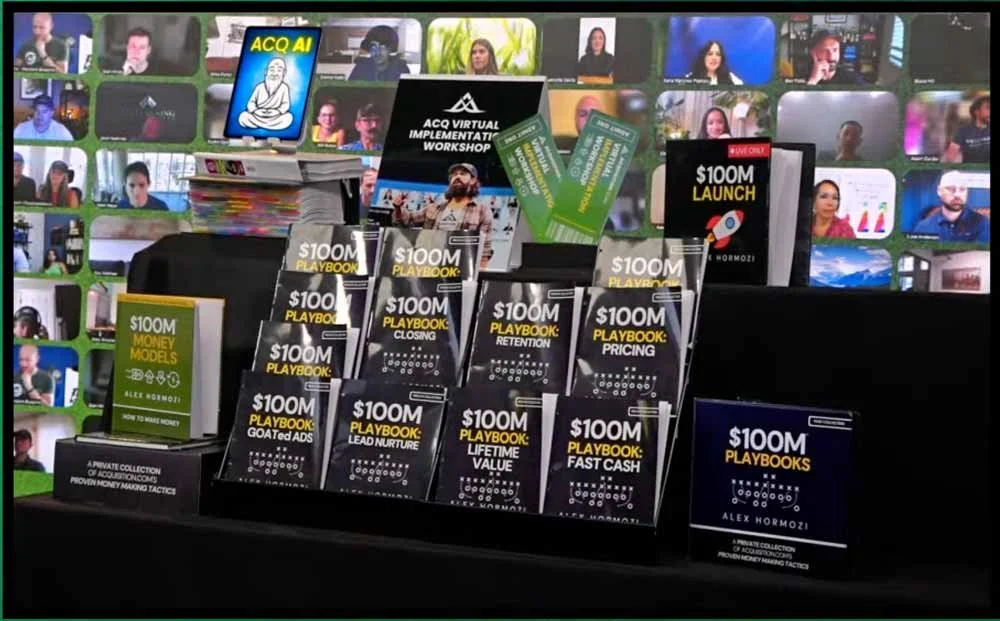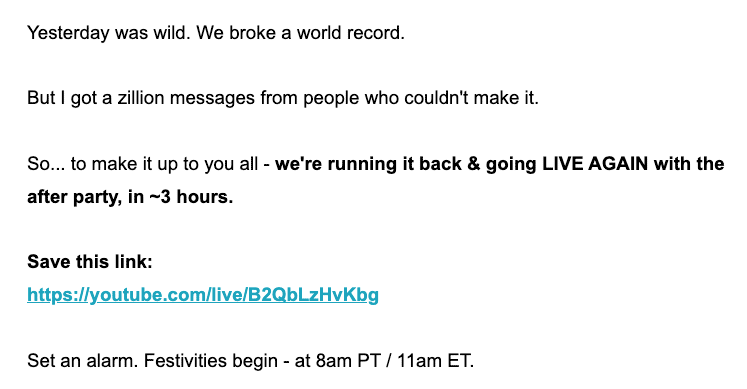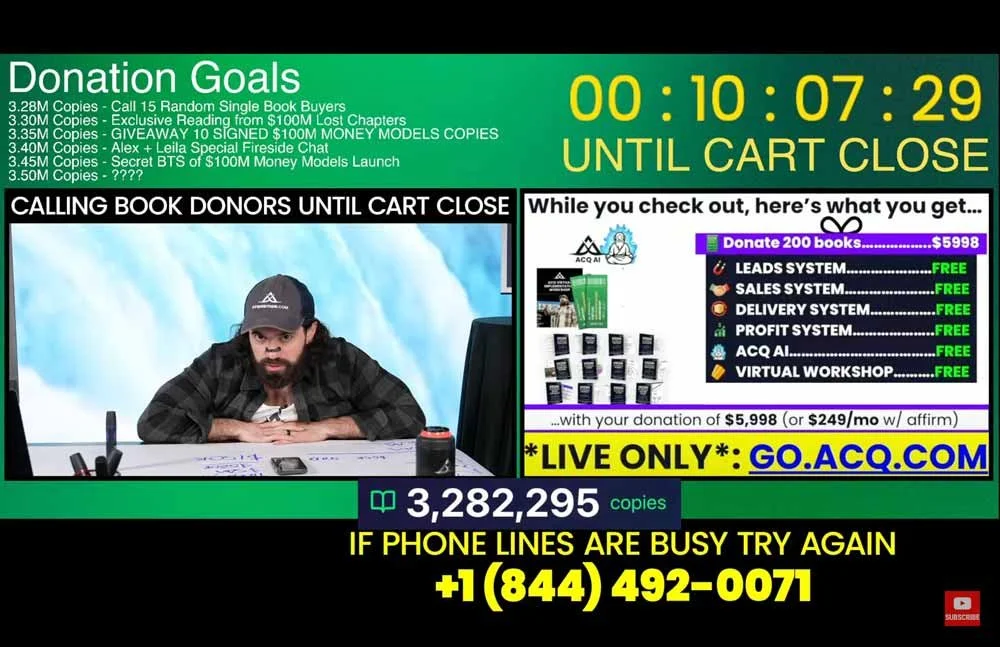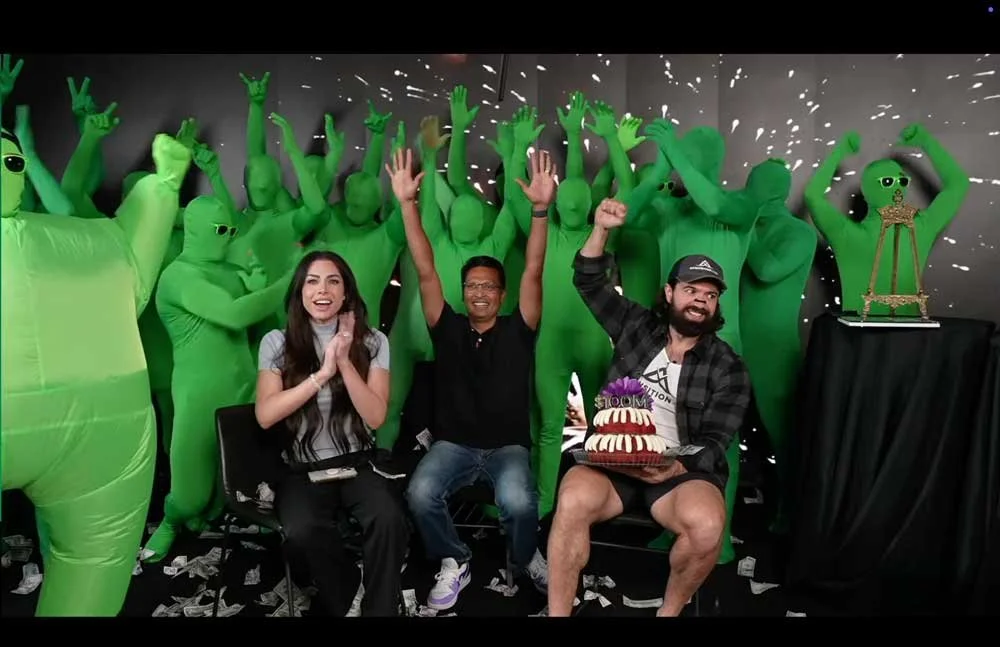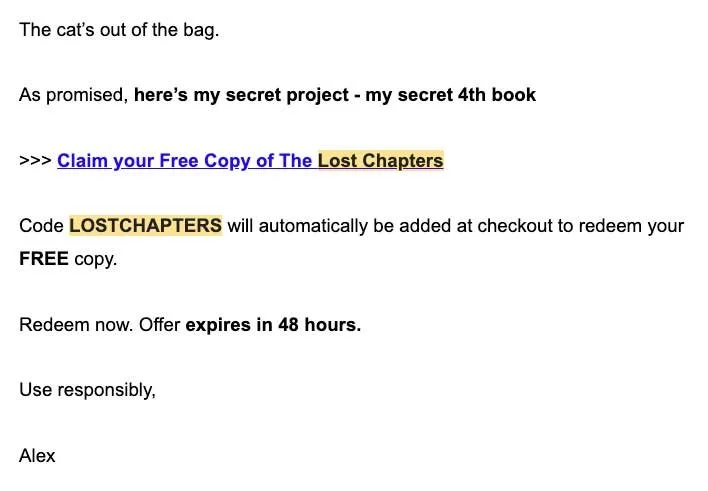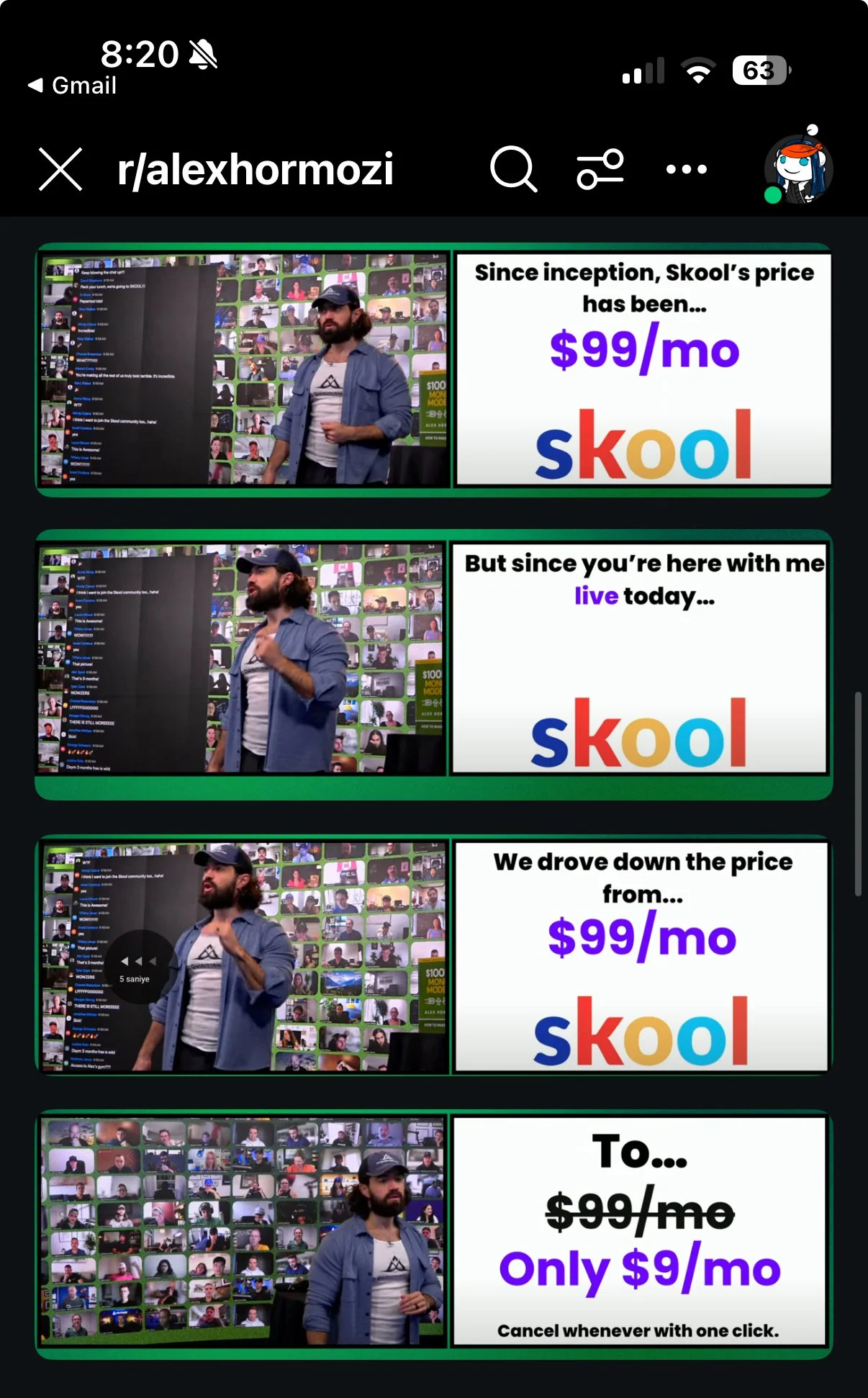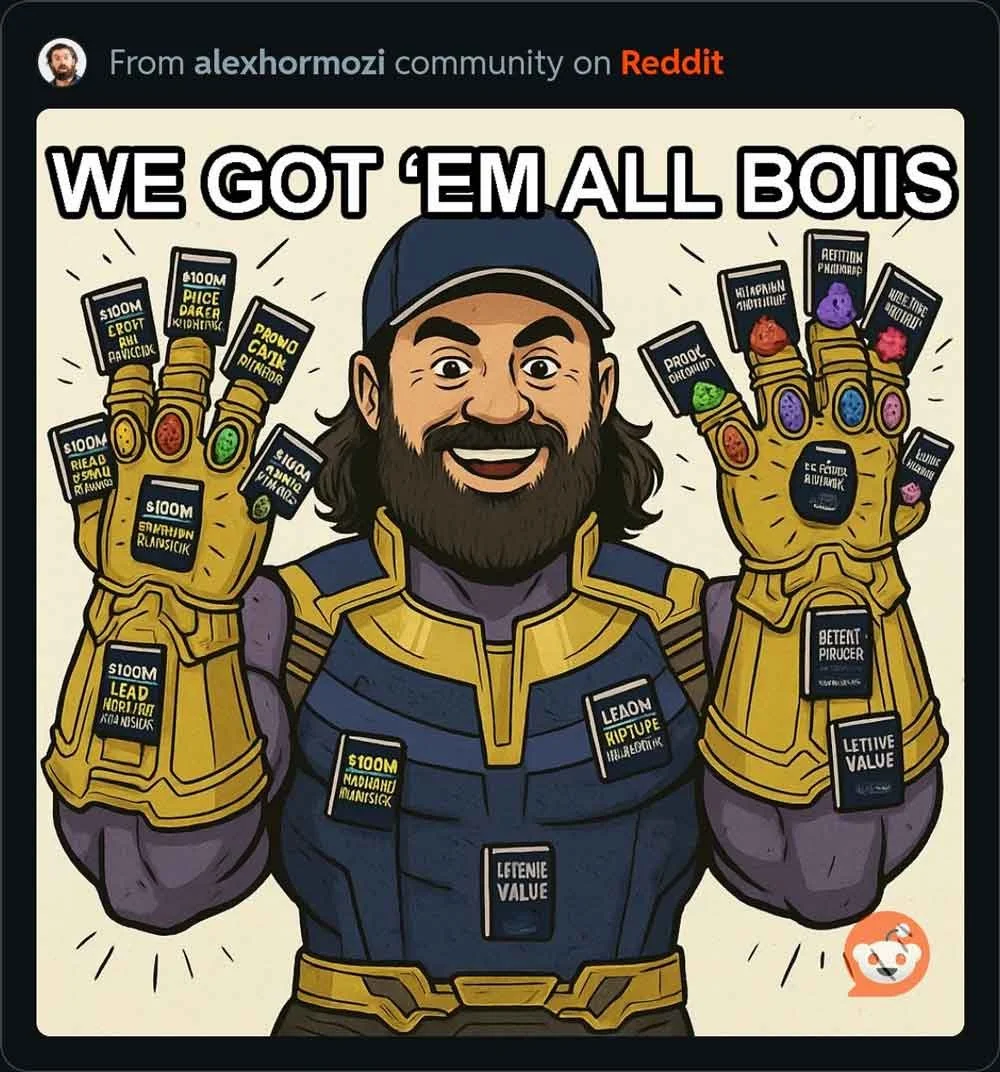Alex Hormozi’s $100M Money Model Book Launch Case Study: 13 Marketing Tactics You Can Steal (and 6 You Should Skip)
Lessons from Alex Hormozi’s world record-breaking $100M book launch strategy — and what you should adapt for your next launch.
Inside the Launch: What This Case Study Covers
I never planned to spend 10 hours glued to a YouTube livestream watching someone sell books on the internet.
But that’s exactly what happened during Alex Hormozi’s $100M Money Models book launch—a 3-day marketing event that broke the Guinness World Record for fastest-selling nonfiction book with over 2.7 million copies sold in 24 hours.
He pulled off what might be the most audacious product launch in recent memory.
This isn't just a recap. It's a tactical breakdown specific strategies I witnessed from the book launch, including 13 you should steal and 4 you should skip if you want to preserve audience trust and brand goodwill.
Whether you love or hate Hormozi's content and style, what he accomplished this weekend is a masterclass in webinar funnels, audience segmentation, and launch psychology
Let’s dive in.
Table of Contents
- How Alex Hormozi’s Marketing Funnel Hooked Me (And Why It Worked)
- The Pre-Launch Funnel: How Hormozi Used Bonus Stacking to Drive Book Pre-Order
- The Affiliate Strategy That Made Everyone Want to Share
- How He Fueled Must-Attend FOMO
- The First Red Flag: The “We’re Live” Fake-Out
- How Hormozi Turned a Sales Goal Into a Shared Mission
- The Attention Hijacking Technique
- The $65K Giveaway That Set Up the Real Offer
- How He Turned a Pitch Into a Crusade
- “Donate 200 Books”: How Hormozi Framed a $6K Ask as a World-Changing Gift
- The Viral Distribution Machine: How He Got Buyers To Market His Books
- The Unboxing: When a Pitch Becomes Performance Art
- The AI That Had Everyone Buzzing: Hormozi On-Demand, 24/7
- Why the Sequencing Made the AI Hit Even Harder
- When Storytelling Becomes Emotional Justification
- Alex Hormozi’s Mystery Headliner Panel: Was It Worth the Hype?
- Leila Hormozi: The Surprise Headliner at the $100M Book Launch
- The Chat Chaos: What Happens When Launch Messaging Breaks Down on a Livestream
- Surprise Streams & The Final Sales Push
- The Numbers That Broke the Internet
- The Backlash: When Marketing Tactics Strain Audience Trust
- Final Takeaways: Ethical Marketing Lessons from a Mega Launch
How Alex Hormozi’s Marketing Funnel Hooked Me (And Why It Worked)
I wasn't in the Hormozi fandom. I had him filed under "bro marketer"—not usually my vibe.
But I was on his email list for one reason: his Mozi Minute emails were genuinely useful. Short, punchy, practical.
Then the green invasion began.
Facebook ads everywhere.
As a digital product creator, I pay close attention and get inspired by how entrepreneurs like Hormozi design their marketing funnels to drive engagement — especially during high-stakes launches.
Hormozi’s book launch ads were impossible to ignore: visually weird, pattern-breaking, and different from the typical business content I’d see.
Bright green colors, men in green bodysuits following Hormozi around, copy that hammered the same core message:
"Get free stuff. Come to the event. Don't miss it."
Curiosity won. I signed up.
Not because I wanted the book (yet), but because I wanted to get a peek behind the curtain of a major launch.
(Later, diving into Facebook's ad library, I discovered he'd created dozens—maybe hundreds—of ad variations his team was testing. The green suit concept was just one of many hooks being optimized.)
💡 STEAL Tactic #1: Pattern-Interrupt Visuals
Use unexpected imagery that stops the scroll.
Why it works:
Your brain pays attention to anomalies. When everything looks the same, weird wins.
How to apply:
Find the visual opposite of what everyone in your space is doing.
The Pre-Launch Funnel: How Hormozi Used Bonus Stacking to Drive Book Pre-Order
After I signed up for Hormozi’s book launch event, the pre-order campaign kicked in immediately. He didn’t wait until the livestream to start selling.
Instead, their pre-launch funnel sent me automated emails and texts, each one reminding about the event AND nudging me to become a VIP by pre-ordering $100M Money Models (which costs $29.99 plus shipping).
The appeal of exclusivity plus bonus stacking created urgency and incentivized why I should buy the book right now.
Here’s what was included with a pre-order:
Exclusive interviews with five "mystery headliners"
Free audiobook version
Priority shipping ("millions of orders coming—get yours first")
Chance to win a day in Vegas with Alex
Each incentive was repeatedly positioned as a VIP-only bonus.
Here’s one of a dozen emails I received pre-launch:
But here's the message that sealed the deal:
““Reminder: People who wait to get their copy at the event will pay the same price but don’t get any of the VIP Benefits.
This means that you get all the VIP bonuses for free if you simply pre-order the book for the same price I’ll offer it at the launch anyway. My way of saying thank you for helping us out.””
This kind of psychological nudge—anchored in inevitability and free rewards—was an effective book marketing strategy.
I bought the book one day before event.
🎯 STEAL Tactic #2: The Low-Stakes Entry Point
Frame your first paid ask as logical, not risky.
Why it works:
Removes decision friction by making the choice feel rational rather than emotional. You're not "buying"—you're "upgrading an inevitable purchase."
How to apply:
Make it about optimization, not risk. Give people a logical reason to say yes to small asks.
The Affiliate Strategy That Made Everyone Want to Share
In one of Hormozi’s emails, I noticed something clever: he wasn’t just promoting his $100M Money Models book directly—he was recruiting affiliates to drive signups for the livestream launch event.
And that’s where the gamified affiliate strategy kicked in:
Sign up to be an affiliate? → Get the The Acquisition.com Affiliate Black Book
Refer 10 people? → Get a bonus audiobook of 70 1-Minute Profit Tactics.
Crack the top 10 referrers? → Win a private fireside chat with Hormozi.
Instead of offering commission payouts (like the typical 10% of each sale), Hormozi offered evergreen content and exclusive experiences as rewards. He kept the revenue, but gave away value-packed digital bonuses.
Smart.
Even smarter? He encouraged affiliates to share those rewards with the people they referred.
That single shift changed the narrative:
Instead of “sell for me and get paid,” it became “help me help your audience—and we all win together.”
It reframed the affiliate strategy into something that felt more like a partnership and less like a transaction.
🎯 STEAL Tactic #3: Collaborative Affiliate Incentives
Make promotion feel like partnership, not extraction.
Why it works:
People resist being "sold to" but embrace being "invited in." When affiliates can share rewards with their referrals, everyone wins.
How to apply:
Structure your affiliate program so the people being referred get value too, not just the promoter.
This wasn’t just a book launch. It was a live demonstration of marketing psychology at scale—and the real event hadn’t even started yet.
How He Fueled Must-Attend FOMO
🙋♀️ Be honest: Have you ever signed up for a live webinar fully planning to just catch the replay at 1.75x speed?
Same.
That's because unless the webinar host promises something unique that I can't get from the replay, it doesn't jump to the top of my priority list. Especially from someone I'm not already familiar with.
But this launch was different.
Hormozi's email marketing and social media kept repeating some variation of:
"There's a secret project I've been working on for years... and the only way to get it is by showing up live."
It wasn't just that line. It was how he doubled down on the exclusivity and curiosity:
The secret project was "worth more than an NFT, but less than a Bitcoin"
Bold, curiosity-driving phrases like "only for live attendees"
Every email and text pushed: Don't miss it. Be early. Show up.
The 5 "mystery headliners" were positioned as people who don't usually speak publicly and had "never all shared a stage before"
That last point made it feel like a once-in-a-lifetime opportunity, which elevated the perceived value of showing up live.
It all worked.
The combination of live-only exclusivity, mystery speakers, and cryptic rewards created real urgency.
I blocked off my calendar, made arrangements for childcare, and committed to attending live—something I rarely do for webinars.
But this also foreshadowed future red flags.
Because if you’re going to build that much anticipation around “exclusive, live-only rewards,” the delivery has to match the promise.
More on that next.
🎯 STEAL Tactic #4: Curiosity-Driven Live Exclusivity
Create genuine intrigue around what people will only get by attending live.
Why it works:
Our brains hate information gaps. The bigger and more specific the mystery, the stronger the compulsion to show up and solve it.
How to apply:
Don't just say "join live for bonuses." Be specific on what they'll miss out on and create a compelling mystery that can only be solved by attending.
The First Red Flag: The “We’re Live” Fake-Out
At 11:30 AM ET—30 minutes before the scheduled start—my phone buzzed:
"We're live now."
I panicked. Was I already late?
I clicked the livestream link and found a 10-15 minute behind-the-scenes video on loop of Alex and his team prepping for the launch. High production value, like a mini-doc hyping the moment.
That's when I realized: I wasn't late. The actual event hadn't started.
"Live now" didn't mean Alex was presenting. It meant the livestream was broadcasting.
It obviously worked—I dropped everything and tuned in early, just like they wanted. But it was also the first hint of a pattern I'd see all weekend:
🚩 Messaging that was “technically true,” but deliberately ambiguous enough to be misunderstood in their favor.
⚠️ SKIP Tactic #1: The "We're Live Now" Fake-Out
Don't say "we're live" when the actual event hasn't started.
Why it backfires:
Creates short-term compliance but long-term trust erosion. People remember feeling tricked into showing up early.
Better approach:
Be creative about early arrival incentives. Offer exclusive content or host early-bird giveaways that reward punctuality without being misleading about the start time.
How Hormozi Turned a Sales Goal Into a Shared Mission
Finally, Alex came on stage and I was riveted.
The first two hours were masterful. High energy, tight pacing, perfect blend of teaching and storytelling.
But it was the psychology that hooked me.
Early on he shared his goal of breaking the Guinness World Record for fastest-selling nonfiction book in 24 hours. (Spoiler: He did.)
Why was this important?
He shared that nine out of the top 10 fastest-selling books belong to politicians, and didn't we think it was time an entrepreneur claimed a spot?
This language was designed to make you feel like you were part of something bigger. This wasn't just about his success—it was about our success. Us entrepreneurs versus the establishment.
It reframed what could easily be seen as a selfish sales goal into a shared mission worth supporting.
🎯 STEAL Tactic #5: Us vs. Them Positioning
Create in-group identity that builds allegiance.
Why it works:
Transforms customers into co-conspirators. Makes buying feel like joining a movement.
How to apply:
Identify your audience's "opposition" and position yourself as their champion fighting the same fight.
The Attention Hijacking Technique
Then came the visual assault:
Zoom wall of his top clients behind him
Split-screen presentation
Over 1,700 slides synced to every sentence
Often I didn't know where to look—which was exactly the point. It created this constant need to PAY. ATTENTION.
Later, they added a live counter tracking book sales in real-time. Every time that number jumped, I guarantee it triggered FOMO for anyone who hadn't bought yet.
🎯 STEAL Tactic #6: Strategic Sensory Overload
Layer visual elements to maintain constant attention.
Why it works:
Creates constant stimulation that keeps people engaged. Your brain can't get bored when there's always something new to process.
How to apply:
Layer visual elements strategically, but make sure each one serves your message rather than just adding noise.
And the teaching itself? Great.
Hormozi took familiar concepts—lead generation, upsells, lifetime value—and made them feel urgent, fresh, and easy to understand through his "Money Models" framework.
That's a gift.
But the real genius was what came next.
The $65K Giveaway That Set Up the Real Offer
After teaching for about 40 minutes, Hormozi shifted into what looked like a typical high-ticket pitch for his $100M Money Models course.
Four separate components with compelling descriptions
Premium pricing anchors ("This normally costs $5,999...")
A $69,995 value stack
Then the classic price drop:
"But you're not going to pay $69,995... or $29,997... or even $9,997..."
At this point, the chat was going wild.
People who had been to his past book launches started chiming in:
“Wait for it. Wait for it. It’s going to be free!”
“He always does this!”
And then the mic drop:
"The entire Money Models Accelerator course is… FREE. Available to everyone."
The chat EXPLODED with cheers and gratitude.
But it wasn't just the course. The free bundle kept growing:
Free audiobook of $100M Money Models
90-day free trial of SKOOL (his tech platform) then a lifetime deal of only $9/month
The big reveal: $100M Lost Chapters - 24 chapters that didn't make it into his three books
He positioned it all as a "free starter kit for up-and-coming entrepreneurs" - the best head start he could give.
But this led to the second red flag. 🚩
Wasn't the Lost Chapters supposed to be the secret "worth more than an NFT, less than a Bitcoin" that was only for live attendees? Now it seemed like everyone was getting it just for registering with their email, even if they weren’t watching the YouTube broadcast live.
Another instance of messaging that felt... flexible.
Then came the transition that transformed the entire energy in the room.
How He Turned a Pitch Into a Crusade
At the beginning of the webinar, Alex said he was trying to help two types of people:
Up-and-coming entrepreneurs (who just got all the free stuff)
Established business owners ready for something bigger.
That's when he pulled out a letter and read this out loud:
““I live in a country that allows me to do business. So I can give this stuff away that costs me money, for free. And I want to tell you why now. So there’s a mission I have here today. I want to show the world that one of us can start from nothing and achieve anything we put our hearts and minds to. So what do I mean by one of us?””
He went on to paint a picture of entrepreneurs as the unsung heroes - the ones who provide jobs, create and innovate, but also take the most risk, pay the most taxes, work the longest hours, miss the most family moments.
Then he said:
““As you know, our mission has always been to make real business education accessible to everyone…I think that if we can help our fellow entrepreneurs grow their business by even a tiny fraction of a percent each, the net effect could literally change the world. And that is the impact I want us to have together.
As usual, I don’t have a course to sell you, I just gave you all that stuff and more away for free. But I am so committed to helping our people change the world for the better, that I do have an amazing gift I’d like to give you when you help me with this.
The more we, this community of entrepreneurs, the very backbone of the world, the more we can work together to get this book into the hands of the people who need it, the more good we’ll be doing for everyone.
Which is why I’d like to invite you to do something big. ”
”
The emotional pitch was clear: this wasn’t just about business or book sales. This was about changing the lives of entrepreneurs everywhere. And he was inviting the audience to join the movement to help him do it.
Then came the audience segmentation:
““So before I tell you what it is, to the beginners who just got all that free stuff, are you going to complain if I incentivize the business people to donate a ton of books?””
With that final pivot, he unveiled the REAL offer.
🎯 STEAL Tactic #7: Give First, Then Segment
Provide massive value to everyone before making premium asks.
Why it works:
Removes resistance and creates goodwill before segmenting your audience. People feel served, not sold to.
How to apply:
Lead with genuine value for your entire audience, then transition to premium offers for those ready to invest more.
“Donate 200 Books”: How Hormozi Framed a $6K Ask as a World-Changing Gift
Put simply, the offer was: Buy 200 books and get a bunch of bonuses.
But of course, that’s not how he pitched it.
Here's where Hormozi's salesmanship and presentation skills really shone.
First, he described how he’d created 12 playbooks containing codified systems that solved the 4 major constraints all businesses face when trying to grow:
LEADS - You can't get enough qualified prospects
SALES - You can't convert prospects into customers
DELIVERY - You can't retain customers long enough
PROFIT - Your bank account just refuses to grow
These playbooks felt like the “real” books serious business owners needed - which is why he segmented out new entrepreneurs previously.
Then he framed his ask by tying it back to his mission he’d mentioned earlier, the one about making “real business education accessible to everyone.”
He said:
““I want to put all 12 playbooks in your hands when you help me put 200 books in the hands of entrepreneurs who need them. That’s $5,998 in book donations.””
With that single sentence, he transformed:
A purchase into an act of generosity
Buyers into philanthropists
His profit into your impact
The donation wasn't framed as transactional—it was framed as generous, mission-driven, and smart. And if you didn't have 200 people to gift them to? He'd donate them for you.
Suddenly, saying yes wasn't about spending $6,000. It was about changing the entrepreneurial landscape AND taking your business to the next level, too.
🎯 STEAL Tactic #8: Mission-Driven Reframing
Transform your offer from transaction to moral imperative
Why it works:
People buy products, but they join movements. When you connect your offer to a larger cause, resistance drops and emotional investment soars.
How to apply:
Identify the bigger mission your product serves. Frame your ask as helping achieve that shared vision, not just buying your stuff.
The Viral Distribution Machine: How He Got Buyers To Market His Books
The ripple effect of his “book donation” strategy went even deeper.
Hormozi created another win-win situation, just like he did with his affiliate strategy. For those willing to pay $6K to donate books, he specifically outlined 3 ways they could leverage them:
As lead magnets to get more leads
As a gift or bonus to new customers for joining a community, attending an event, or leaving a testimonial
As an onboarding gift for new employees to train them faster
After the launch, I saw entrepreneurs online immediately using those strategies. One entrepreneur, Jason, used his books as an incentive for a webinar signup. Lori gifted them as a bonus to event attendees.
Hormozi hadn’t just crafted a generous offer—he’d engineered a viral distribution machine. By turning his buyers into strategic partners, he gave them a way to grow their own businesses while simultaneously turning them into his most effective book funnel.
Alan Beck summed it up perfectly in this Facebook post:
“People aren’t aware…
Alex Hormozi got millions of online marketers to promote his stuff for free 😄
He offers some “free coaching” for a few winners.
His coaching takes literally no time to do and as a result, he has most likely collected millions of emails and contacts.
Don’t do what he says, do what he does 😉
For every 1 email he’s collected, he probably makes about $20-50 per email.
Maybe even more as the people who don’t buy from him probably watch his stuff on social media where he monetises and makes money as well.
Always look into why something works and why certain people keep using certain strategies that make them millions.
It’s not his books.
It’s his ability to get millions of marketers to hand over their email lists to him and for free.
Food for thought 🐣"
--- Alan Beck
The Unboxing: When a Pitch Becomes Performance Art
To kick off the offer reveal, Hormozi summoned his “million dollar men” (the green bodysuit-clad actors from his ads) to roll out a two-tiered shelf.
Then, in a move that felt more like a stage performance than a sales pitch, he began unboxing his 12 hardcover playbooks—each one representing a proprietary framework built from consulting over 1,000 businesses.
For every book, he followed the same ritual:
Explained the core system inside
Shared a client insight or success tied to it
Told a brief transformation story
Then carefully placed it upright on the shelf, trophy-style
And he didn’t rush it. Hormozi spent over 31 minutes walking viewers through each playbook, from about timestamp 1:02 to 1:34 on the livestream.
The slow, deliberate pacing was a trust-building tactic. By taking his time, he created weight and meaning behind each playbook. It made the overall offer feel more valuable, more irresistible. This wasn’t a “bundle” of fluff—it was 12 strategic systems unboxed one at a time, like precious collectibles.
As the stack grew, so did the visual impact. The shelf filled with tangible proof of results, and the books remained in view for the entire livestream - which ended up lasting almost 10 hours!
Always visible. Always reminding you of what you were missing if you didn't act.
🎯 STEAL Tactic #9: The Trophy Stack
Gradually build your offer with visual proof and strategic pacing.
Why it works:
When you take time to reveal each part of your offer, you create a sense of weight, meaning, and momentum. The audience processes the growing value in real time. With each new element, the offer starts to feel more substantial. Not just a bundle of stuff, but something thoughtfully crafted and worth getting.
How to apply:
Instead of listing everything upfront, slow down. Reveal each asset one by one, paired with a quick story or bit of context. Let the pacing build suspense and highlight the intention behind what you’re offering.
Ready to have your own high-converting playbook?
I’ll turn your process into a playbook that sells, scales, or simplifies your delivery.
Email me at hello@conquerthedigitalempire.com with the subject line Playbook and share:
What your business does
One process or method you’d love to scale
I’ll reply personally to see if it’s a fit.
The AI That Had Everyone Buzzing: Hormozi On-Demand, 24/7
But wait, there’s more!
Right after stacking all those playbooks on screen, he brought out a thick binder of his actual consulting notes from the past several years.
Then he unveiled the AI.
Meet ACQ AI, his proprietary assistant trained on everything he’s ever produced: books, personal notes, consulting frameworks, and internal systems.
He described it as an AI version of himself, built to answer the exact kinds of business questions people used to pay him tens of thousands to consult on.
Even after walking us through the playbooks for over 30 minutes, he anticipated a common objection many business owners might have:
“But will this work for me and MY business?”
That’s where he positioned the AI as the perfect solution.
He explained the AI was built to help you apply the systems, strategies, and frameworks for your unique situation in a matter of seconds. Essentially saying: It’s like having Hormozi on speed-dial, 24/7.
That’s a hard offer to resist.
To make it even more actionable, he included an ACQ Implementation Virtual Workshop to walk users through how to use the AI to the best if it’s ability. Smart, because the best tool in the world is useless if you don’t know how to leverage it.
The chat went wild. I could feel the excitement through the screen. People were typing:
“I want the AI more than the books!”
Honestly? Same.
If you’ve ever been stuck mid-launch or wrestling with a big business decision, having a smart advisor on demand is a massive value-add
This tapped into something I've been noticing across the high-ticket consulting space:
Experts are building AI agents of themselves. It's scalable mentorship—always available without you giving up more hours.
Hormozi positioned it perfectly: deeply personal, highly strategic, and tailored to your business.
🎯 STEAL Tactic #10: Productize Your Expertise with AI
Package your expertise into formats that serve people at scale—without you in the room.
Why it works:
It solves the “trading-time-for-money” trap by turning your knowledge and decision-making into a product people can access 24/7—without sacrificing the personal touch. When done right, even AI can feel tailored because it’s trained to respond with context that mirrors your brain.
How to apply:
Start with your proven frameworks, tools, or client insights. Then ask: how can this be experienced without me? Whether it’s an AI, a diagnostic tool, or a guided template, the key is delivering value in a 1-to-many format.
📚 Want your own high-converting playbook?
I'll turn your process into a playbook that sells, scales, or simplifies delivery.
📩 Ready to turn your expertise into an asset?
Email me at hello@conquerthedigitalempire.com with the subject line Playbook and share:
- What your business does
- One process or method you'd love to scale
I’ll reply personally to see if it’s a fit.
Why the Sequencing Made the AI Hit Even Harder
The reason ACQ AI felt incredible wasn’t just what it was—but when it was revealed.
He first displayed the 12 playbooks, each a tested business system drawn from his work with thousands of entrepreneurs. That built trust and demonstrated proven value.
Then he brought out a super thick binder of his actual consulting notes to visually reinforce that the AI was also trained on real, refined consulting wisdom.
THEN posed the exact question that causes most buyers to hesitate:
“But will this actually work for me?”
If he had led with the AI, it wouldn’t have hit nearly as hard. But by sequencing it after the playbooks, it turned into a gotta-have-it offer—one that felt earned, not hyped.
🎯 STEAL Tactic #11: The Proof-Before-Promise Sequence
Establish credibility with evidence before revealing your biggest offer.
Why it works:
When you lead with proof—results, frameworks, or real-world insights—then escalate to your main promise, it makes your pitch feel earned rather than exaggerated. You're not asking people to trust you; you're giving them reasons to believe first.
How to apply:
Structure your presentations or sales content in this order: 1) Show tangible evidence of what works, 2) Build on that credibility, 3) Then reveal your most compelling offer or transformation. Your proof becomes the foundation that makes your promise feel inevitable, not inflated.
When Storytelling Becomes Emotional Justification
Before bringing out his mystery headliners, Hormozi did something subtle but powerful.
He paused the pitch energy and got personal, saying:
"If you've ever gotten value from any of my free stuff...please donate some books."
Then he started listing. Fast, almost offhand, but comprehensive:
The Scaling Roadmap
Free courses
YouTube videos
Mozi Minute emails
Podcast clips
Everything he'd given away for years
Hearing that list hit me.
I realized: this wasn't just a product launch. This was a culmination.
Every piece of content he’d put out was him patiently building to this moment. Stacking goodwill. And if you'd been following him awhile, I’d imagine buying the books felt like the natural next step, not a random sales grab.
Even I briefly thought:
"Alex has given so much. It actually feels right to give something back."
Then he went deeper, sharing his research on the risk-to-reward decision frameworks of history's wealthiest people.
His finding? Inflection points—moments when people made bold, all-in decisions—were almost always at the center of big wealth leaps.
That became the bridge to his most vulnerable content: the 10 biggest decisions he ever made as an entrepreneur. Each story was specific, raw, and real. Like flying to California to open his first gym with no money, no backup plan, no real clue what he was doing.
After every story, he'd pivot back to the playbooks: "This could be your inflection point. Right now."
The framing was brilliant. It’s like he was getting us to look in the mirror and ask ourselves : "Am I at a moment where I'm ready to bet on my next level?"
🎯 STEAL Tactic #12: The Goodwill Payoff
Leverage free value as emotional foundation for your ask.
Why it works:
Transforms selling from extraction to exchange. When people have genuinely benefited from your free content, buying feels like gratitude, not risk.
How to apply:
Before any major launch, remind your audience of the journey you've taken them on. Make the connection between past value and future opportunity explicit.
Alex Hormozi’s Mystery Headliner Panel: Was It Worth the Hype?
One of the biggest draws for me to show up live was Hormozi's promise of five mystery headliners—entrepreneurs positioned as heavy-hitters who "don't usually speak publicly and had never all shared a stage before."
Phrased that way, I expected a roundtable where we'd see these business titans interact, trade stories, maybe even disagree on approaches.
That's not what happened.
Instead, Alex brought them out one at a time for short, 10-minute interviews. He led the questions, and while the guests offered interesting answers, it was very much the Alex Hormozi Show.
Especially with the first guest—it felt more like Alex explaining their business back to the audience than a real-time exchange. The guest would offer a quick answer, and Alex would jump in with a breakdown, translating it into his own frameworks.
Don’t get me wrong—the insights were solid. But the execution didn’t quite match the “never-before-seen panel” buildup the marketing promised.
What was visually smart: During each interview, Alex sketched out their business model in real time on a long strip of paper. The camera would cut between the conversation and an overhead view of his live drawing.
It kept things dynamic and reinforced his positioning as a systems thinker. Everything mapped back to his Money Model.
🚩 But I couldn’t shake the feeling that the “mystery headliners” were more of a marketing hook that set expectations the actual experience didn't quite meet.
⚠️ SKIP Tactic #2: Deliberately Vague Promises
Don't use technically true language that misleads about the actual experience.
Why it backfires:
"Shared a stage" is technically accurate but implies panel interaction. People feel misled when they realize the gap between implication and reality, even if you didn't technically lie.
Better approach:
Be specific about format and experience. Say "five individual deep-dive interviews" instead of relying on vague language that sounds bigger than it is.
Leila Hormozi: The Surprise Headliner at the $100M Book Launch
Alex surprised us with a secret 6th headliner:
Leila Hormozi, Alex's business partner, wife, and powerhouse entrepreneur in her own right.
I knew nothing about Leila going in, but she absolutely stole the show for me.
She had this grounded, confident presence. Calm. Sharp. Articulate. Everything she said felt practical, delivered with this quiet authority that made me lean in and listen.
Early in her segment, she dropped a line that stuck with me:
““You don’t need to show people your journey until you’ve built a track record. So many people want to be famous before they’re even good.””
That one hit.
Her whole message was about putting in the reps before stepping into the spotlight.
And I got my wish to hear more from her.
Later, as the livestream stretched into the 7-hour mark and Alex finally took a break, Leila stepped in as host alongside their company president to answer audience Q&A .
And again, she crushed it. By the end of the event, one of my biggest takeaways wasn’t just about marketing.
It was this: I need to follow Leila Hormozi.
The Chat Chaos: What Happens When Launch Messaging Breaks Down on a Livestream
As the livestream went on for more and more hours, the tide started to shift in the YouTube chat.
This was the point where large parts of the audience started to get confused. Frustrated. Desperate.
Viewers kept typing "Where's the free stuff??"
At one point, someone typed "free ebook" and suddenly a wave of people commented that, too,—"free ebook free ebook free ebook"—as if that phrase would unlock the goodies.
It was chaos.
You could tell there were people who:
Showed up expecting an instant download link
Missed the part where Alex said the bonuses just for attending would drop Tuesday
Thought they needed to stay until the end of the livestream to claim something…and they wanted to know how much longer they had to wait
Others were trying to calm the crowd:
"Guys, the bonuses drop Tuesday."
"He already said this."
But the chat was moving so fast that helpful information got buried instantly.
The chat really highlighted the complexity of launching at this scale. At one point, 86,000+ people were watching live. Multiple tiers of offers and bonuses had been shown depending on when and how you opted in.
Confusion was inevitable, especially around what was going away at the end of the livestream.
🚩 This was a real-time example of how even a record-breaking livestream can go sideways when your audience isn’t 100% clear on what’s happening or what they’re supposed to get.
⚠️ SKIP Tactic #3: Complex Offers Without Clear Communication
Don't layer multiple offers and bonuses without crystal-clear, repeated explanations.
Why it backfires:
When you have live-only bonuses, email signup bonuses, pre-order bonuses, and donation bundles all happening simultaneously, people get confused about what they qualify for. Add misleading language like "live attendee only" (when email signup was enough), and confusion turns to frustration.
Better approach:
If you're going to run complex, multi-tiered campaigns, invest heavily in communication clarity. Repeat key details obsessively. Better yet, don't attempt this level of complexity unless you have a team that can manage the messaging flawlessly.
Surprise Streams & The Final Sales Push
The original Saturday, August 16th, livestream was already a marathon—nearly 10 hours of teaching, pitching, Q&A, and incentives.
So on Sunday when I got an email with subject line After Party Live in ~3hrs, I was surprised. Here’s what it said.
Another full livestream? Yep, and that one ran about 7 hours.
No heads-up, no teaser during Saturday’s broadcast—just a brand new stream positioned as a response to those who “missed Day 1.”
I didn't watch the whole thing but when I briefly joined, I recognized the encore performance: teaching, offer, incentives, hot seat coaching, and Q&A.
Then came Monday—a THIRD livestream and a final push for sales. Turns out the deadline for the 200 book bundle was expiring Monday at midnight Pacific Time.
But Monday’s livestream added a new twist: gamification. On screen, two live counters kept ticking:
⏳ Countdown timer until the cart closed
📚 Real-time tally of books sold
Each time the “books sold” counter hit a major milestone, Alex unlocked a new surprise:
Hit 3.28 million → Randomly call 15 single-book buyers for hot-seat sessions
Hit 3.35 million → Give away 10 signed copies of Money Models
Hit 3.45 million: Unlock secreat behind-the-scenes panel with him, Leila, and Sharran Srivatsaa (president of Acquisition.com)
That last one? Gold.
They pulled back the curtain and shared how Acquisition.com’s infrastructure made a launch of this scale possible, from event production and ad spend to managing affiliates and physical product fulfillment. It felt like getting access to the launch's "secret chapter." Loved it.
Then, with about three hours left until cart close, they hit 3.5 million copies sold! At that moment, Alex's birthday was celebrated live on stream. Green-suited men appeared bringing cake.
It was silly, fun, and weirdly humanizing after a high-pressure weekend.
🎯 STEAL Tactic #13: Gamified Goal Tracking
Turn your launch goals into shared milestones that unlock community rewards.
Why it works:
When progress unlocks surprises, your audience gets emotionally invested in the outcome. They don’t just want to watch you succeed—they want to *trigger* your next win.
How to apply:
Add progress bars or live counters that lead to community bonuses. Make people feel like co-pilots, not just passive viewers. Think: every sale or signup brings everyone closer to the next reward.
The Numbers That Broke the Internet
Reports quickly surfaced about Hormozi’s mind-blowing results:
Broke the Guinness World Record of “Fastest Selling Non-Fiction Book in History” with around 2.7 million book copies sold in 24 hours
Earned an estimated $84 million in a single day
Sold 3.5+ million copies of his book in 3 days
But here's where it gets really interesting: right after the $6,000 "donate 200 books" offer, Alex introduced an upsell—a continuity mastermind priced at about $18,000, structured as six monthly payments of $3,000.
Word in the entrepreneur community suggested around 700 people took that offer. If accurate, that's an additional $12+ million on top of everything else.
Conservatively, across those three days—individual book sales, donation bundles, and high-ticket upsells—he likely passed the $150 million mark in gross sales.
The Backlash: When Marketing Tactics Strain Audience Trust
Once the launch ended, I did what many digital marketing nerds do after a big event: I went digging to see the reactions.
Down the rabbit hole I went: Reddit threads, Facebook posts, YouTube comments. All had a mix of longtime fans, skeptics, critics and haters sharing their hot takes.
While many praised the ambition and sheer achievement of the launch, a growing number of viewers pointed to moments where the marketing crossed into manipulative territory. Not in the spammy guru way but in the subtle, technically-true-but-still-misleading way.
Here’s what I saw come up again and again:
Fake FOMO: When “Live-Only” Turns Into “Always Available”
Leading up to August 16, all messaging suggested the event would be one-time only. A single day, single livestream.
Which implied that “live-only bonuses” would only be offered once.
So people (myself included) cleared their schedules to be there.
Then came the surprise 7-hour stream on Sunday.
The reason given? That many people had messaged in saying they missed Saturday.
But some suspected the real reason: they didn’t hit Day 1 sales goals, so another livestream was added to push more bundles.
Even bonuses labeled as “live only”—like the Launch Ads Playbook—were re-offered on day two.
To be fair, maybe it was always planned to be multiple days. Or maybe the decision was made mid-launch. But either way, the lack of transparency created a sense of bait-and-switch. When something is marketed as “you’ve got one shot,” but that turns into three, trust erodes.
I might’ve believed that the other livestreams were truly unplanned if the other fake fomo tactics hadn’t happened.
Because it didn’t stop there.
Remember how the pre-launch emails repeatedly said:
“I’m giving away the secret thing that’s better than an NFT but less than a Bitcoin…but the only way you’ll get it is by showing up live.”
That “secret thing” turned out to be The Lost Chapters—a bonus book that wasn’t actually restricted to live attendees at all.
Since the event was hosted on YouTube Live (no login required), there was no way to verify who was watching live. And later, a follow-up email revealed that anyone who had registered for the event could get the book for FREE using a discount code. No live attendance needed.
Again, not malicious. But definitely misleading.
When phrases like “live-only” get repeated over and over—only for the experience to tell a different story—audiences notice. And they remember.
⚠️ SKIP Tactic #4: Fake Exclusivity FOMO
Don’t manufacture exclusivity unless you actually mean it.
Why it backfires:
“Live-only,” “one-time event,” and “only way to get this” create urgency. But if those promises unravel—even slightly—it erodes audience trust. Especially among your most engaged fans who followed your directions
Better approach:
If something truly is live-only, make it verifiable—like an attendee-only Zoom session or unique digital key.
If you're not certain something will be exclusive, don’t say it is. Instead, use urgency tied to availability (“limited quantity”) or timeline (“72 hours only”) that you can confidently enforce.
And if you do change your mind mid-launch? Just own it. Transparency keeps trust intact, even when plans shift.
The Skool Discount: Confusion & Manipulative Messaging
During the livestream, Hormozi presented another major bonus for bundle buyers: a special deal with Skool, a community platform he co-owns with Sam Ovens and invested in back in 2024.
The promise?
A 90-day free trial (far longer than their standard 14-day offer)
A lifetime discount: $9/month instead of the usual $99/month
Except… that wasn’t exactly true.
What attendees really got was a 90-day free trial to either the standard $99/month Pro Plan or a newly introduced $9/month Hobby Plan.
But the Hobby Plan came with a catch: a much higher transaction fee: 10% compared to just 2.9% on the Pro Plan.
Worse? Facebook commenters pointed out that the $9 Hobby Plan had quietly gone live to the public even before the launch.
So what was framed as a “special launch-only deal” turned out to be publicly accessible—and less valuable than it sounded.
The reaction?
Users felt duped, especially those who believed they were getting lifetime access to the $99 tier for just $9.
This Reddit post sums up the disappointment regarding the “wordplay and manipulation” used.
I actually think this could’ve landed differently.
If the bonus had been clearly framed as: “We’re giving you a special 90-day trial and early access to a new $9/month beginner plan,” most people would’ve welcomed it.
Not as exciting as a steep discount on the Pro Plan—but his other bonuses were already strong enough to carry the offer.
There was no need to risk trust with language that felt like a bait-and-switch.
⚠️ SKIP Tactic #5: Misleading Messaging Through Ambiguity
Avoid language that implies more than the offer delivers.
Why it backfires:
Vague or overly clever copy can create hype in the short term, but it breeds disappointment when the details surface. When audiences feel a gap between what was promised and what was delivered—especially in pricing or exclusivity—they lose trust fast.
Better approach:
Be exact in your wording. If the deal is a 90-day free trial followed by access to a new beginner tier, say that. If a $9/month Hobby Plan has tradeoffs (like higher transaction fees), disclose them. Your audience will respect transparency more than spin—especially when your offer is already strong enough to stand on its own.
Leaked PDFs via AI “Hacking”
One of the biggest draws for the $6,000 bundle was exclusivity.
Buyers were promised a set of 12 hardcover playbooks (printed, not digital) containing proprietary systems developed from Alex Hormozi's years of consulting work. Add in access to ACQ AI (trained on those same systems), and the offer became irresistible for those wanting both elite-level insights and the tool to apply them.
Then the leaks started.
Within days of the launch, Reddit users shared that they'd hacked the AI to extract the training PDFs. Despite Hormozi never selling digital editions, those versions were now floating around online, with some users blatantly selling the pirated content.
The scavenger hunt feel of finding all the leaked playbooks became like a quest to collect all the Infinity Stones.
But here's where it gets interesting: Given Hormozi's previous books and other content have been leaked online—and his stated mission of making business information freely accessible — there's a strong possibility this wasn't entirely unexpected.
He may have calculated that collecting $80M+ upfront was worth the inevitable piracy risk, especially since most of his buyers likely have no idea this even happened. So far from what I can tell, leak discussions were largely contained to Reddit's r/alexhormozi community, which represents a fraction of his customer base.
If most buyers remain unaware, does the leak actually damage the offer's perceived value? For Hormozi, the answer might be "not really," especially if the viral distribution through Reddit communities becomes bonus reach at zero cost.
I’ve seen buyers who did discover the leaks felt cheated that others could access the same "exclusive" content for free.
Like user Consistent-Beach7314 posted:
““ACQ Al is solid, but there are real questions about data use, privacy, and security. We also had no way to judge if it was worth $6k before buying. Once everything else in the bundle showed up free online, ACQ Al became the only gated value. Even the implementation workshop will likely leak.
I don’t think this is the experience you wanted for the people who support you most. Please consider making this right with something that cannot be leaked or a partial refund. A move like that would go a long way toward rebuilding the trust and goodwill of buyers who paid in good faith and are struggling to see $6k of unique value beyond what the public got.””
But strategically speaking, Hormozi may have played a longer game: collect the revenue, accept the inevitable piracy, and let the leaks extend his influence even further.
⚠️ SKIP Tactic #6: Weak Content Security for Premium Offers
Don't sell premium, exclusive content without strong safeguards — or face piracy consequences.
Why it backfires:
When high-priced content is leaked or hacked immediately after launch, it devalues the offer for your paying customers. Especially if the content is positioned as physical-only or deeply proprietary. Leaks lead to buyer's remorse and can damage trust in future premium offers.
The safer approach:
Build non-replicable value into premium offers—exclusive communities, live experiences, or personalized access that can't be pirated. This way, even if core content leaks, your paying customers still receive unique value that justifies their investment.
Final Takeaways: Ethical Marketing Lessons from a Mega Launch
The reactions I saw didn't just criticize the tactics. They questioned the ethics. Was the urgency real? Was it fair to play with audience expectations like that? Was the team deliberately misleading, or just underestimating how savvy their viewers really are?
As someone who teaches launches and user experience, this felt like a fascinating case study in messaging clarity at scale. Because when you're operating at this level, every phrase matters. If there's ambiguity, people will speculate to fill in the blanks, and not always in a positive way.
It made me reflect on my own launches and how to balance marketing impact with ethical strategy:
How do I ensure everything I promise is something I actually deliver—not just technically, but emotionally?
How do I build real urgency without sacrificing integrity?
How do I communicate clearly and transparently so my audience keeps trusting me, even when things don’t go as planned?
Watching all this unfold—and then seeing how people responded—was a strong reminder that launch tactics aren't neutral. They shape how people feel, how they talk, and ultimately, whether they stay.
As much as I admire the ambition and execution of this launch, it reminded me of what I want to double down on in my own work.
Here’s what I’m walking away with and what might help you too:
Generosity works when it's rooted in genuine value, not just optics
Segmentation is a great way to respect where people are in their journey
Hype without alignment creates more damage than momentum
Every touchpoint (emails, bonuses, offers) either builds or breaks brand trust
It reminded me that how I make an offer is just as important as what I offer.
Planning your own launch?
Here are some questions to help you also decide what to steal or skip from Hormozi’s event:
What tactics align with your values and feel authentic to deploy?
What strategies can be scaled down to your current audience size?
What parts of the offer design you can reverse-engineer using your own expertise?
What started as curiosity about Hormozi’s launch became a masterclass in what's possible when strategy meets scale—and a reminder that the best tactics in the world mean nothing if they don't feel true to who you are.
💡 Want to turn your internal framework into a high-converting playbook?
Imagine what a playbook could do for your next offer, bonus stack, or team delivery system.
I'll turn your framework into a done-for-you playbooks that you can:
- ✅ Sell as a digital product
- ✅ Use to boost conversions
- ✅ Hand off to a team for consistent delivery
No writing required — I’ll handle the heavy lifting.
📩 Ready to turn your expertise into an asset?
Email me at hello@conquerthedigitalempire.com with the subject line Playbook and share:
- What your business does
- One process or method you'd love to scale
I’ll reply personally to see if it’s a fit.
Share if you found this helpful:

